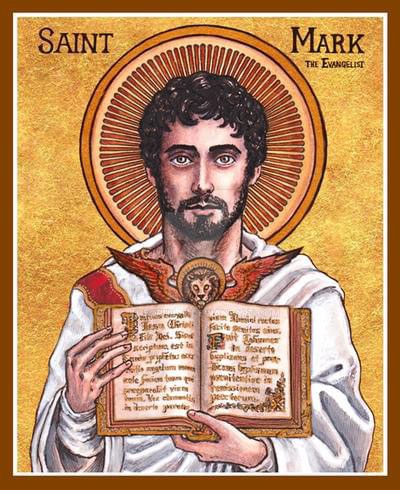
It’s important to note that on April 25th, the most perfect day in the whole calendar (not too hot or too cold, just enough for a light jacket in the morning) the church remembers the writer of what many consider to be the perfect Gospel account: Saint Mark, Evangelist and Friend of Brevity.
In the ancient days the church would take to the hillside on April 25th singing the Greater Litany in an attempt to neutralize any mildew that might even think about affecting the budding wheat harvest, a nod to the many agrarian examples that dot the Gospels, including the Gospel of Mark.
Mark’s Gospel is, as far as we can tell, the oldest Gospel in the canon (though certainly not the oldest writing in the New Testament). He is usually associated with John Mark, mentioned in the book of Acts, though the name “Mark” in ancient days was kind of like the name “Mary” back then: everyone and their brother seemed to bear the name (in fact, John Mark’s mother was named Mary).
Speaking of John Mark’s mother, if the Gospel writer is the same Mark as the one written of in the Book of Acts, then his mother hosted one of the first house churches recorded in the scriptures (check out Acts 12:12). Some even think it was perhaps this house, Mark’s house, where the disciples met for the Last Supper.
The John Mark of Acts went with his cousin St. Barnabas and St. Paul in their first missionary work (with St. Barnabas taking the lead…we forget that Barnabas taught Paul, not the other way around). Somewhere on this journey St. Mark and St. Paul became frienemies (Paul had a way of making enemies of those who would be his friends), and Paul decided that St. Mark would not be joining him on his other missionary journeys. Though they eventually made peace with one another, it’s interesting to note that the early church leaders were often butting heads.
Especially the loudest ones.
Saint Mark is often called the “interpreter of Saint Peter,” mostly because tradition holds that Saint Mark wrote his Gospel using the memory banks of that sage and salty Apostle. It is said Saint Mark went on to become the Bishop of Alexandria (though this may be mostly lore), and that he was martyred in 64 C.E. because he attempted to keep people from worshiping the god Serapis. In the mid 9th Century the remains of Saint Mark (or, at least what was called his remains) were moved from Alexandria to Venice, and are now in the cathedral there.
In many places throughout the world April 25th has been a “rogation day,” marked by processions through crop fields and prayers for a good planting season. In the 7th Century the church coopted this pagan processional meant to keep biological pests at bay through prayer and purification, and made it a liturgical act. In fact, once the church coopted this practice, the legend grew that it was on April 25th that Saint Peter entered Rome for the first time, and since Saint Mark is Saint Peter’s interpreter…well…they gave Mark the feast day and he forever became associated with both the litany and rogation festivals.
Saint Mark’s apostolic symbol is that of a lion. This figure, borrowed from the prophet Ezekiel, gives a visual to what Mark’s Gospel account is: fierce and loud, striking hot and fast. In Mark Jesus is always on the move. In Mark little details are swiped over in deference to big picture ideas. In Mark Jesus is the most human, seemingly glib to his Divine appointment in many instances.
All of the above makes Mark my favorite Gospel by far. I’m not big on Matthew’s attempt to fulfill prophecy, Luke’s penchant for inane details, or John’s flowery words and tortured imagery.
Mark gets the point and invites the reader/hearer to draw their own conclusions.
I like that.
Saint Mark is a reminder for me, and should be for the whole church, that sometimes brevity says more than tortured details can ever say. May everyone who writes a sermon hear.
-historical bits gleaned from Pfatteicher’s New Book of Festivals & Commemorations
-icon written by Theophilia at DeviantArt
